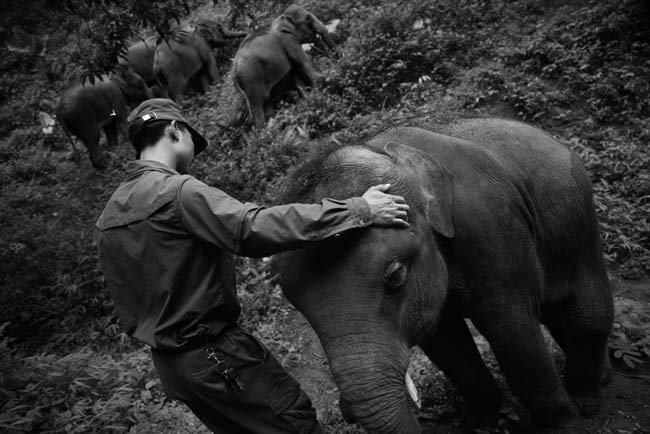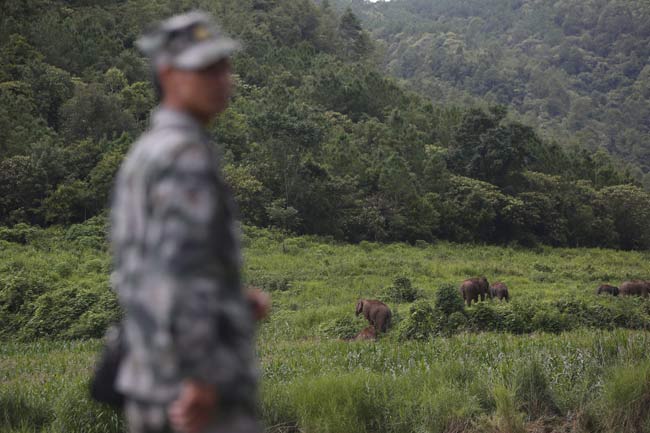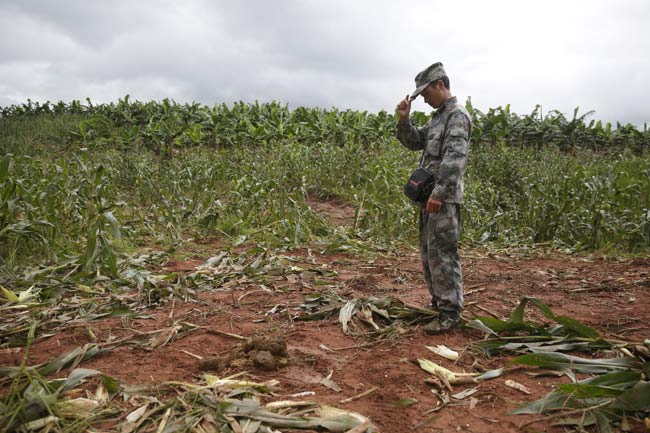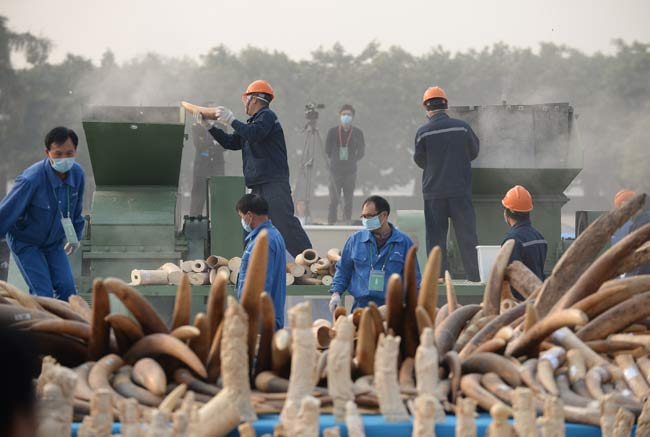
A member of staff at an elephant breeding and research center helps an elephant calf return to the wild. [Photo by WU HAO / FOR CHINA DAILY]
Huashiban, Yunnan province — Wild Asian elephants have been wreaking havoc in villages in Southwest China as their habitat is destroyed and they’re forced to search for food.
Cai Yansheng will never forget March 13. It was the day his wife was trampled to death by rampaging wild elephants searching for food.
Early in the morning, Cai’s wife, Zhang Defen, 61, left home to sprinkle pesticide over the couple’s banana fields. “She was only supposed to work on the land for an hour or so,” Cai said.
As noon approached and Zhang had still not returned to the house, the elderly farmer began to sense that something was wrong. “I ran to the banana field, but I didn’t see her,” he said. “I found her bag lying on the ground, then I saw her feet “
To his horror, Cai realized that body parts were scattered across the field.
Unsurprisingly, the 70-year-old from Huashiban village, Pu’er, Yunnan province, breaks down in tears whenever he tells the story.
The incident wasn’t an isolated event, though; on April 12, a herd of wild elephants attacked farmers working in cornfields in the village. Despite their popular public image and their protected status as an endangered species, the elephants are a major problem for the villagers, who say that in addition to the human cost, the animals also gorge the crops and ruin people’s livelihoods.

A man observes a herd of wild Asian elephants at Huashiban village, Pu’er, Yunnan province. Elephants regularly visit the village in search of food, trampling and destroying crops.[Photo/WU HAO / FOR CHINA DAILY ]
Escalating conflict
When the elephants first arrived in Huashiban three years ago, the villagers were excited, but the damage the animals have done has resulted in mixed feelings toward the animals.
According to Liu Wei, an official in Zhengdong town, which administers Huashiban in Jiangcheng county, 18 wild Asian elephants first came to the county on Oct 18, 2011, from the neighboring city of Xishuangbanna.
Their numbers rose to 24 in 2013, and now 43 live in the area. “The amount of damage they cause is growing too,” Liu said.
According to information published on the local government website, the elephants live in three separate herds and mainly reside in a nearby mountainous region called Maofei. Their area of activity covers about 35 square kilometers under the jurisdiction of three villagers’ committees. “That’s about 70 households, comprising 2,691 people,” Liu said, adding that the elephants visit the farmers’ land regularly throughout the year, and are most active at dawn and dusk.
By the end of 2013, the cost of the damage had reached 10 million yuan ($1.63 million), according to the government website.

A man observes a herd of wild Asian elephants at Huashiban village, Pu’er, Yunnan province. Elephants regularly visit the village in search of food, trampling and destroying crops.[Photo/WU HAO / FOR CHINA DAILY]
Diminishing habitat
Yunnan province is the only remaining habitat for China’s wild elephants, who are estimated to number about 200 at most. However, since 1992, human activity has resulted in the depletion of their natural habitat, and the elephants have taken to entering villages in Pu’er and Xishuangbanna, where they have destroyed crops and houses, and injured the local residents.
The villagers lived in fear of the elephants and are hostile toward them. As a result, the human-elephant conflict has escalated, perpetuating a vicious cycle.
The reason elephants invade human areas is that their habitat and food resources are diminishing rapidly, according to experts.
According to Zhang Li, a professor of behavioral ecology at Beijing Normal University, there are 165 to 213 Asian elephants living in Yunnan. Zhang and his students have been monitoring elephants in the province since 1999.
“We analyzed satellite photos from 1975 to 2005, and they show that the elephants’ natural habitat has been reduced from 5,000 square kilometers to 2,700 sq km, mainly because of the growth of rubber and tea plantations. As the rain forest has diminished and become more fragmented, the elephants have had to adapt to the changed circumstances and look for food in villages,” he said.
In the 1970s, Yunnan started to grow rubber. The expansion of the industry has destroyed the rain forests, the elephants’ natural habitat, a problem compounded by forest fires, illegal logging, the construction of roads and the expansion of villages and cities. Moreover, the habitat has become fragmented, leaving different herds of elephants isolated from each other and preventing the exchange of genes.
Elephants eat more than 160 types of plants, including corn, bananas, buckwheat, rice, sugar cane, bamboo, and plantains, but the lack of food in the wild has forced them to search for fodder in the local farms, where they can find sugar cane, pineapples and bananas by the hectare and gorge themselves, Zhang said.
He noted that the rise in the number of villages and farms has completely blocked the corridors that once connected different elephant reservations, making it difficult for the animals to migrate when they need to look for food during the dry season.
“Elephants in the wild have to go around all day long looking for food, but in the farms it is very easy for them to feast. They bring other members of their herd, and the family will stay around and harass the village for a long time,” Zhang said.

The number of tusked elephants killed is rising because of the ivory trade. [Photo/Xinhua]
Struggle for a solution
He Yong, the communications and program officer with the International Fund for Animal Welfare, said: “You can’t simply tell the villagers they should protect the elephants.
“The peasants rely on the crops for their annual incomes. The elephants come and eat (the crops) and trample their fields, leaving nothing for the farmers to harvest. With the villagers’ survival at stake, it’s simply too much to ask for them to protect the elephants,” he said.
In an attempt to resolve the problem, the local government has provided microloans to help the farmers diversify the types of crops they grow, urging them to plant crops the elephants won’t eat, such as coffee, tea and nuts, so they will have a fallback option if their traditional crops are trampled.
“It works. At the very least, it reduces the local resentment toward the elephants,” He said.
The fund has recently wound up three five-year elephant conservation projects. From 1999 and 2003, the organization started providing micro-financing in Pu’er to help the locals build an alternative economy, thus alleviating agricultural dependency in elephant habitats and reducing the impact of the damage the animals inflict on local communities.
From 2003 to 2008, the project was extended to the Xishuangbanna area, but the final phrase (2008-2013) was halted because banks and local rural cooperatives are now offering similar services and more money. The original microfinancing project was not index-linked to inflation, so the amounts on offer dwindled as the value of the money was eroded by rising prices. The fund will now explore other solutions, according to Cao Dafan, an officer with the fund’s Asian elephant Program.
The fund has also developed the Village Monitoring and Precautionary System in selected villages to help locals better protect themselves and their crops and, in turn, mitigate the conflict between humans and elephants.
In addition, the fund has cooperated with local governments and research institutes to conduct scientific research that helped the local nature reserve complete Geographic Information System mapping and design an elephant corridor to enable their habitat to be enlarged in Xishuangbanna, according to He.
Education programs have been put into place by the fund, too. The programs target communities, schools and tourists to help people gain a better understanding of the elephants and the rich biodiversity of the region.
This approach has been criticized by some experts, though. Professor Zhang said the diversification of crops won’t solve the problem in the long term, and urged the local government to compensate the villagers for their losses.
However, the government says it lacks funds. Yin Ling, deputy head of Jiangcheng county, said the law on wildlife conservation says the local government should provide compensation for damage caused by wild animals, but the local authority’s precarious finances mean the compensation plan has failed to satisfy the villagers.
In 2011, the county government paid out 692,000 yuan to the villagers. In 2012 it bought insurance, but the cover was inadequate, and although the total loss was 3.81 million yuan, the insurance company only provided compensation of 1.51 million yuan.
Although the government announced on its website that the level of compensation is expected to be higher this year, by the end of July that hadn’t happened.
According to Yin, the compensation paid for damaged maize is 2.5 yuan per kilogram, and for sugar cane fields, it’s 700 yuan per mu, or 10,500 yuan per hectare. “The level of compensation is less than half the market price,” he said.
Locals such as Cai, whose farms were not allocated by the village, receive no compensation for their damaged crops. Cai was compensated for the loss of his wife, though, and received 70,000 yuan.
“I believe that protecting elephants and improving people’s livelihoods are two completely different things,” Yin said. “To solve the problem, we really need more help, financially and intellectually, from society as a whole.”
